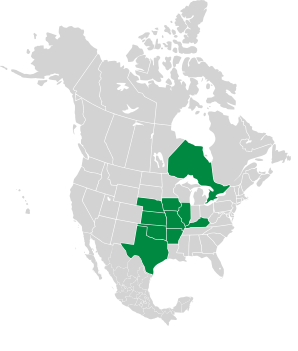Baptisia minor Lehm.
Baptisia texana Buckley
Baptisia vespertina Small ex Rydb.

|
Baptisia australis (L.) R. Br. var. minor (Lehm.) Fernald Blue false indigo
Blue false indigo is native to North America. Baptisia means "to immerse"—a reference to this plant's use for creating dye, and australis means southern (not Australian), though I cannot find out what is southern about this species. Minor probably refers to the smaller size of this variety. Identification: Plants are 1½-2′ (45-60 cm) high. Leaves occur in groups of three, each about 1″ (2.5 cm) long, and are bluish green. It's pea-like flowers, appearing at or in a spike near the top, are lavender-blue. Fruits are brownish-black hard pods ¾-1¾″ (2-5 cm) long × ⅜-½″ (1-1.5 cm) wide. Compared below are varieties of blue false indigo, along with real indigo, which looks very different. |
5/15/2010 · Garden in the Woods, Framingham, Massachusetts |
|||||||||||||||||||||||||||||||
|
| ||||||||||||||||||||||||||||||||
Indigofera tinctoria |
Baptisia australis |
You are here Baptisia australis var. minor |
||||||||||||||||||||||||||||||
|---|---|---|---|---|---|---|---|---|---|---|---|---|---|---|---|---|---|---|---|---|---|---|---|---|---|---|---|---|---|---|---|---|
| Common Name |  |
 |
 |
|||||||||||||||||||||||||||||
| Plant | Shrub, to 6′ (1.8 m) high. | 3-5′ (1-1.5 m) high, about 1½-3′ (50-99 cm) around. | 1½-2′ (45-60 cm) high. | |||||||||||||||||||||||||||||
| Flowers | Pink/violet flower clusters, each flower ½″ (1.3 cm). | Light blue to dark purple. | Lavendar-blue. | |||||||||||||||||||||||||||||
| Leaves | Pairs of opposite, rounded leaves on thin, vinelike branches. Leaflets about ¾″ (1.9 cm) long. | 1-1½″ (2.5-3.8 cm) long, green, bluish green, or grayish green, in groups of 3. | Bluish-green, in groups of 3. | |||||||||||||||||||||||||||||
| Fruit | Clusters of bean pods, each 2″ (5 cm) long. | ⅞-3″ (2.5-7.5 cm) × ⅜-⅞″ (1.2-2.5 cm), bluish-black. | ¾-1¾″ (2-5 cm) long, brownish-black. | |||||||||||||||||||||||||||||
| Range/ Zones |
|
|
|
|||||||||||||||||||||||||||||
| Habitats | Rich woods, thickets, meadows, stream banks | |||||||||||||||||||||||||||||||
| Type | Wild | Wild | Wild | |||||||||||||||||||||||||||||
Medical: Blue false indigo has been used to treat a wide range of ailments, described at Wikipedia and pfaf.org. A tea from the roots served as emetic and purgative. In poultices or in the mouth, it served as an anti-inflammatory. Many other uses have been documented as well.
Online References:
The Lady Bird Johnson Wildflower Center
Baptisia minor Lehm.
Baptisia texana Buckley
Baptisia vespertina Small ex Rydb.
Baptisia australis var. minor description by Thomas H. Kent, last updated 16 Sep 2020.
© FloraFinder.org. All rights reserved.
Range: Zones 3-8:
